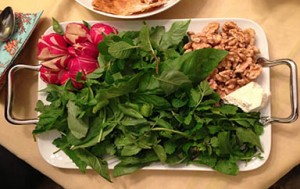 The plate of fresh herbs served with almost every meal is sabzi khordan, which means to eat greens or herbs.Many of the herbs used in Persian cooking can be found in most grocery stores. A few are difficult to find unless you have access to a Persian or Afghani market. It would be rare to use all of the herbs listed here at one time. And replacements can always be made using any green herbs that you like.Note that the English spelling of the Persian words is a transliteration of the Farsi. For this reason most of these words may also be found under alternative spellings. Sometimes the “oo” is written as “u”, “i” may be “ee”, and a soft “a” may be “ā”.To find more about Persian cuisine visit Wikipedia – Persian Cuisine.“Noosh-e jan” (Persian equivalent of bon appetit).
The plate of fresh herbs served with almost every meal is sabzi khordan, which means to eat greens or herbs.Many of the herbs used in Persian cooking can be found in most grocery stores. A few are difficult to find unless you have access to a Persian or Afghani market. It would be rare to use all of the herbs listed here at one time. And replacements can always be made using any green herbs that you like.Note that the English spelling of the Persian words is a transliteration of the Farsi. For this reason most of these words may also be found under alternative spellings. Sometimes the “oo” is written as “u”, “i” may be “ee”, and a soft “a” may be “ā”.To find more about Persian cuisine visit Wikipedia – Persian Cuisine.“Noosh-e jan” (Persian equivalent of bon appetit).Persian Herb List
| English | Persian | Farsi (فارسی) | Genus Species |
|---|---|---|---|
| Basil | Reyhan | ریحان | Ocimum basilicum |
| Cilantro | Gishniz | گشنیز | Coriandrum sativum |
| Cress | Shahi | شاهی | Lepidium sativum |
| Dill | Shevid | شوید | Anthemum graveolens |
| Fenugreek | Shanbalileh | شنبلیله | Trigonella foenum-graecum |
| Green Onion | Piazcheh | پیازچه | Allium fistulosum |
| Persian Leek | Tareh | تره | Allium ampeloprasum var. persicum |
| Mint | Nanah | نعناع | Mentha X piperita |
| Parsley | Jafary | جعفری | Petroselinum crispum |
| Persian Shallot | Moosir | موسیر | Allium hirtifolium, Boiss |
| Radish | Tarbocheh | تربچه | Raphanus sativus |
| Saffron | Zafaron | زعفران | Crocus sativus |
| Tarragon | Tarkhun | ترخون | Artemisia dracunculus |
Herb Menu
Reyhan — Basil
 Basil: In America, Persians eat either Thai basil or common sweet basil. There is one variety of basil, O. basilicum ‘Licorice’, that is known as Persian or Anise basil due to its licorice smell. Because of this, Thai basil makes a better substitute.
Basil: In America, Persians eat either Thai basil or common sweet basil. There is one variety of basil, O. basilicum ‘Licorice’, that is known as Persian or Anise basil due to its licorice smell. Because of this, Thai basil makes a better substitute.
In Iran there are usually two types of basil available. One has small leaves with a purple tint and a strong smell. It is similar to the Thai basil pictured here but with smaller leaves and a flower that has more green than purple. It is mainly eaten fresh.
Return to herb menu
Gishniz — Cilantro
 Cilantro: This is the same cilantro commonly found in America. It is eaten fresh and used as an herb in cooking.
Cilantro: This is the same cilantro commonly found in America. It is eaten fresh and used as an herb in cooking.
Return to herb menu
Shahi — Cress
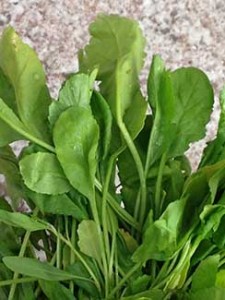 Cress: Cress or garden cress is an herb similar to water cress. There are two words for cress in Farsi; shahi is the more common but tartizak (ترتیزک) is also used. Cress has a peppery flavor. It is used fresh because it doesn’t dry into a usable form. For this reason it is sometimes available live in small planters. It is easily grown if you would rather have it very fresh and not have to search for it at the market.
Cress: Cress or garden cress is an herb similar to water cress. There are two words for cress in Farsi; shahi is the more common but tartizak (ترتیزک) is also used. Cress has a peppery flavor. It is used fresh because it doesn’t dry into a usable form. For this reason it is sometimes available live in small planters. It is easily grown if you would rather have it very fresh and not have to search for it at the market.
Return to herb menu
Shevid — Dill
 Dill: Widely used in Persian cuisine both fresh and in cooking. Although dried forms are available, most Persians use the fresh tender green portion of the plant. Some Persian markets have frozen herbs that can be used for cooking. Dill seeds are used in other cuisines but not in Persian cooking.
Dill: Widely used in Persian cuisine both fresh and in cooking. Although dried forms are available, most Persians use the fresh tender green portion of the plant. Some Persian markets have frozen herbs that can be used for cooking. Dill seeds are used in other cuisines but not in Persian cooking.
Many tasty Persian dishes use large amounts of dill. Dishes such as shevid polow and bahgali polow use about 3 cups of fresh dill to 1 ½ pounds of rice.
Return to herb menu
Shanbalileh — Fenugreek
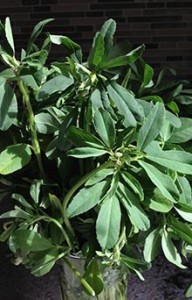 Fenugreek: Most western recipes requiring fenugreek use the spice, which is the ground seeds, not the fresh leaves. The spice has a pungent flavor and is sometimes roasted to reduce the bitterness. Persian cuisine however, uses the herb or fresh leaves of fenugreek rather than the dried seeds. It is used both as an herb and as a vegetable in cooked dishes. Fresh fenugreek has green clover-like leaves and an aroma similar to the ground seeds but milder and a fresh grassy taste.
Fenugreek: Most western recipes requiring fenugreek use the spice, which is the ground seeds, not the fresh leaves. The spice has a pungent flavor and is sometimes roasted to reduce the bitterness. Persian cuisine however, uses the herb or fresh leaves of fenugreek rather than the dried seeds. It is used both as an herb and as a vegetable in cooked dishes. Fresh fenugreek has green clover-like leaves and an aroma similar to the ground seeds but milder and a fresh grassy taste.
Persian grocers usually have dried fenugreek but rarely fresh. However, you can find fresh fenugreek at Indian markets under the Hindi name mehti.
Return to herb menu
Piazcheh — Green Onions
 Green Onion: These are the same scallions or green onions used in many parts of the world. The white of the bulb and lower stems make a nice contrast to the green or the other herbs.
Green Onion: These are the same scallions or green onions used in many parts of the world. The white of the bulb and lower stems make a nice contrast to the green or the other herbs.
Green onions are also used in cooking.
Return to herb menu
Tareh — Persian Leek
 Persian Leek: This herb is also known as broad leaf leek. Some references refer to this as a garlic chive but it is more closely associated with leeks. It is flatter and wider than chives and only the stems and leaves are used, not the bulbs.
Persian Leek: This herb is also known as broad leaf leek. Some references refer to this as a garlic chive but it is more closely associated with leeks. It is flatter and wider than chives and only the stems and leaves are used, not the bulbs.
Tareh is served fresh as part of sabzi khordan and chopped for stews and egg dishes. They add a flavor similar to leeks.
Return to herb menu
Nanah — Mint
 Mint: Used fresh and occasionally freeze dried in stews when fresh isn’t available. Shown here is peppermint which has a menthol flavor. It is recognized by the relatively smooth-edged leaves, compared to spearmint which has saw-tooth edged leaves.
Mint: Used fresh and occasionally freeze dried in stews when fresh isn’t available. Shown here is peppermint which has a menthol flavor. It is recognized by the relatively smooth-edged leaves, compared to spearmint which has saw-tooth edged leaves.
Return to herb menu
Jafary — Parsley
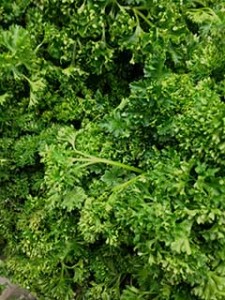 Parsley: The broad leaf variety is most commonly used in sabzi khordan but both curly leaf and flat leaf are used in cooking. The curly leaf type is also used for decoration such as on fish or salad olivieh.
Parsley: The broad leaf variety is most commonly used in sabzi khordan but both curly leaf and flat leaf are used in cooking. The curly leaf type is also used for decoration such as on fish or salad olivieh.
Return to herb menu
Moosir — Persian Shallot
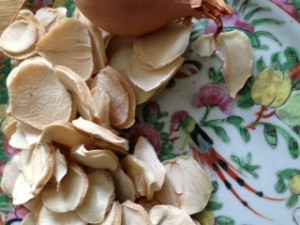 Persian Shallot: Persian shallots are called moosir (also musir and mooseer) but most translation dictionaries don’t distinguish them from common shallots. allium cepa aggregatum group is a wild plant, growing mainly in Iran that has been over-collected. The bulbs are similar in size and shape to shallots, white skinned, and one or rarely two bulbs per plant.
Persian Shallot: Persian shallots are called moosir (also musir and mooseer) but most translation dictionaries don’t distinguish them from common shallots. allium cepa aggregatum group is a wild plant, growing mainly in Iran that has been over-collected. The bulbs are similar in size and shape to shallots, white skinned, and one or rarely two bulbs per plant.
A common use for moosir is with yogurt (in Persian “mast”, pronounced mahst) which is also commonly served along with the sabzi khordan for most meals.
The dish mast-o moosir can be purchased at Persian grocers, but many would rather make their own. This has led many Persian immigrants to look up moosir and find that it translates to shallot. They then purchase shallots, mix them with yogurt, and are disappointed with the taste. It just isn’t the same as the mast-o moosir they are familiar with.
The problem is compounded because of inaccuracy of many web resources on this plant. A Wikipedia article Wikipedia claims that moosir is the bulb of Leopoldia. I can’t find any other web reference in English or Farsi to substantiate this claim.
Dried moosir such as that shown in the figure is available through on-line stores but it’s very expensive. Dried is the most common form used in Iran.
Tarbocheh — Radish
 Radish: The small red-skinned radishes Raphanus sativus found in American grocery stores are the same as those often used in sabzi khordan. These add a little spiciness to the mixture. Persian food includes many herbs and spices but this is about as hot and spicy as Persian food gets.
Radish: The small red-skinned radishes Raphanus sativus found in American grocery stores are the same as those often used in sabzi khordan. These add a little spiciness to the mixture. Persian food includes many herbs and spices but this is about as hot and spicy as Persian food gets.
Return to herb menu
Zafaron — Saffron
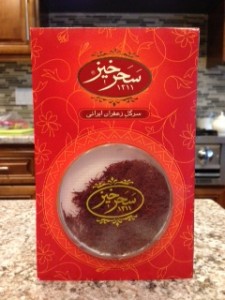 Saffron: Saffron is used in a variety of Persian dishes. Some of the more popular ones include saffron ice cream, saffron pudding (sholeh zard), and a dessert called halva. Sholeh zard means yellow flame referring to the saffron color of the dessert. But, the most common usage for saffron is in Persian rice or polow. For polow a saffron and water mixture is poured over the cooked rice to add a bright yellow to some of the rice making a beautiful contrast to the white rice.
Saffron: Saffron is used in a variety of Persian dishes. Some of the more popular ones include saffron ice cream, saffron pudding (sholeh zard), and a dessert called halva. Sholeh zard means yellow flame referring to the saffron color of the dessert. But, the most common usage for saffron is in Persian rice or polow. For polow a saffron and water mixture is poured over the cooked rice to add a bright yellow to some of the rice making a beautiful contrast to the white rice.
Saffron threads are always ground and then steeped in hot water prior to use in Persian cooking. Saffron serves two purposes – to flavor and to color. It adds a bright yellow to rice and a darker yellow to other dishes. Before adding, the threads are ground to a fine powder with a mortar and pestle, adding a pinch of salt or sugar to the mortar helps to make the fine powder required.
Return to herb menu
Tarkhun — Tarragon
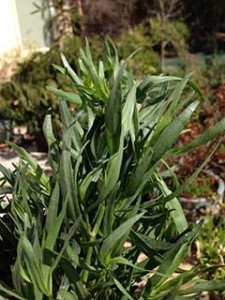 Tarragon: This is another herb that is mainly used fresh in sabzi khordan or as part of an herb mixture. Persians use the more aromatic variety French tarragon. It isn’t used as a primary flavor as it is in French cooking.
Tarragon: This is another herb that is mainly used fresh in sabzi khordan or as part of an herb mixture. Persians use the more aromatic variety French tarragon. It isn’t used as a primary flavor as it is in French cooking.
Return to herb menu